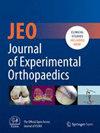The anteroposterior femoral translation starting angle and the medial pivot pattern are correlated with the range of motion after total knee arthroplasty
Abstract
Purpose
Postoperative range of motion (ROM) of the knee is an important factor for improving clinical scores and symptoms in total knee arthroplasty (TKA). This study aimed to investigate the relationship between intraoperative factors, including anteroposterior translation of the femur, and extension and flexion gaps, observed during posterior-stabilized TKA (PSTKA) using a navigation system, and preoperative and postoperative parameters.
Methods
Twenty-one knees with osteoarthritis that were treated by PSTKA were included. ROM and clinical outcomes, including the Hospital for Special Surgery Knee Score (HSS score), were measured before and one year after surgery, and intraoperative kinematic factors were measured using an image-less navigation system. We further divided the subjects into two groups based on the presence or absence of postoperative flexion contracture (defined as an extension angle ≤ –5°at one year after surgery). The no contracture group comprised 12 knees, and the contracture group comprised 9 knees.
Results
The postoperative extension angle correlated with the starting angle of the anteroposterior translation of the femur (r = –0.60; p < 0.01) and the postoperative HSS score (r = 0.46; p = 0.04). The postoperative flexion angle correlated with the lateral-to-medial anteroposterior translation ratio (r = 0.47; p = 0.03), indicating a medial pivot pattern. In comparison to the contracture group, the no contracture group had a significantly smaller starting angle of the anteroposterior translation of the femur in comparison to the contracture group (no contracture, 30.6° ± 17.0°; contracture, 48.4° ± 16.7°; p = 0.02) and a significantly higher postoperative HSS score (no contracture, 90.8 ± 7.0; contracture, 81.1 ± 11.8; p < 0.05).
Conclusions
This study revealed that knee joints with flexion contracture after PSTKA had a significantly larger starting angle of anteroposterior translation during surgery and that an intraoperative medial pivot pattern was beneficial for postoperative flexion angles.
Level of Evidence
Level III.





 求助内容:
求助内容: 应助结果提醒方式:
应助结果提醒方式:


